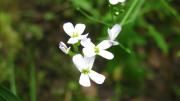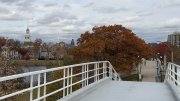A typical day went like this. We had candidate sites from the scientific literature, regions where Arabidopsis arenosa had previously been found. Plotted on Google Maps, they made a rough, connect-the-dots loop. This was the route that the grad student in charge and I followed for two weeks and more than 2,000 miles, through Hungary, Transylvania, and Romania's Carpathian Mountains, driving hours at a time. When we reached a site, we'd find a likely-looking cliff, park the car, and start hiking. Our goal: to find wild A. arenosa plants and collect their seeds, which we could grow and study in the lab.
I’m working on my senior thesis in the lab run by assistant professor of organismic and evolutionary biology Kirsten Bomblies. The lab studies the genetics of A. arenosa, a rock cress in the mustard family. Some populations of A. arenosa, like most animals, have two copies of each chromosome, one from the mother and one from the father. But most A. arenosa populations have four copies of each chromosome, all from the same species, a common phenomenon among plants. Many crop plants—strawberries, wheat, and sugar cane, among others—are hybrids that carry multiple sets of chromosomes from different species, and this sort of hybridization is a common strategy to improve crop robustness. But having extra copies of each chromosome is an organizational nightmare in the finely tuned process of cell division: cells sometimes lose chromosomes, or pick up new ones. In humans, missing and extra chromosomes are involved in diseases as varied as Down’s syndrome and cancer. A. arenosa has had its extra set of chromosomes for a long time, and the lab wants to know how it has adapted to the challenge.
Our plant is a small wildflower, about the size of the scrubby weeds you’d find in an abandoned lot. It prefers limestone outcrops, usually clinging to cracks in the stone. What I looked for when I looked for plants: the clusters of four bright, white petals, the slender leaves and long, thin stalks supporting the flowers, the whole plant rarely longer than my forearm. Beyond that, there was something about how the plant took up space, its spindly, wraith-like form, that became somehow familiar, unmistakable. After the flowers are pollinated, the petals drop off and the seeds begin to develop. They form a neat row in seedpods called siliques, which start out green but turn yellowish-brown as they mature. We collected the siliques and dried them, and then we separated out the tiny brown seeds, smaller and lighter than sesame seeds, and sent them back to the United States.
The plants took us to abandoned quarries and steep gorges. Ruins of a medieval castle, huge chunks of mossy limestone looming in dense forests. Cold, clear mountain streams and a shallow, warm lake. Once we saw a bear. (Luckily, the bear saw only its dumpster dinner.) For the most part we were far from cities, far from places I'd have thought to go. We drove along two-lane highways past pointed haystacks and vast fields of oats and wheat, and my favorite, sunflowers in bloom. We saw villages and farmhouses and herds of cattle. In Romania we often shared the road with horse carts.
Some days we found plants early. Those were good days. Many days (too many) we didn't find plants at all, after hours of searching. I wondered why. Why this mountain and not another, what the difference was. It's true that landscapes feel viscerally different from one another. The color palette is subtly altered, the sense of space and patterns of light. The Carpathians are high and rugged; the trees are mostly evergreens—tall and straight, deep blue-green on white-gray cliffs; the smaller, smoother Transdanubian mountains in western Hungary, broad-leafed trees and thick leaf litter.
In the lab, I feel as though I can control things. Water is distilled and deionized. Samples are isolated and handled with disposable pipette tips to prevent contamination. Our plants grow in windowless growth chambers like space capsules, with set cycles of temperature and light. I deal with small things at a time—test tubes the length of a thumbnail and volumes on the order of microliters. I study small, specific things—the effect of a single change in a single gene—because this is the scale I know how to understand, where it feels as though my influence is not yet drowned out by complexity. Science operates on this idea of control, and small (small) differences.
Out there, I realized that so much was out of our control. Sometimes we found plants at high altitudes, where the weather was still cold and the fruits not yet ripe. Other times the plants had already been seared by the sun; their fruits had splayed open and scattered the seeds, and the whole plant was brown, withered, scorched. We found plants damaged by herbivory and the culprits: hungry caterpillars. Site to site, there were substantial differences in climate, soil type, ecosystem. It was overwhelming. And exciting.
Being out there reminded me why I do this. As we traveled, I'd notice the differences from place to place, but I didn't know what they meant. I wished I could read the landscape. Written all across it is a story about how things came to be. I would read the earth's upheaval and how tectonic plates collide, the colors and textures of the rocks, what the land was made of. The plants, too—I'd read the leaves and stems and flowers and know their histories. I'd be able to see the little drama unfolding, the plants and animals and the countless tiny organisms in the soil and air, living and sharing and interacting; now cooperating, now at war.
I would read all of this, all of these stories in the tiniest details of landscapes and living things, and when I was done, I'd know why things are the way they are. At the end of it all I'd walk through a forest and see the signs that everywhere tell about things hidden and invisible. I'd follow them, and they would show me what I was looking for.
Here you are, I'd say to the plant. I found you.













